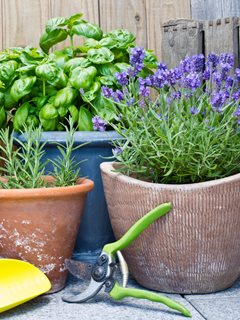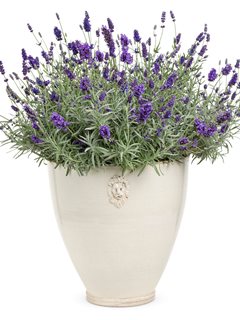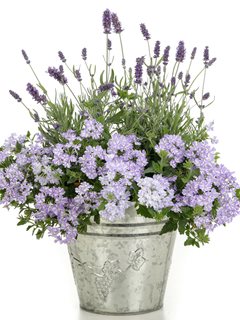A Guide to Growing Lavender in Pots
Get tips on planting and caring for potted lavender, along with suggestions for selecting the perfect container-friendly variety.If you love lavender but don’t have the right soil or exposure conditions to make it thrive in your garden, why not try growing it in a pot? With its silvery foliage and showy spikes of purple flowers, lavender is a stunning container plant, either alone or in mixed arrangements. Plus, growing lavender in a container offers other advantages, including easier harvesting of its fragrant blooms and the ability to enjoy your plant on a patio, balcony, or even indoors.
Like lavender growing in the garden, potted lavender is very low maintenance and drought-tolerant, making it the ideal container plant for gardeners who have little time to water. As long as you meet its basic needs, this perennial herb can thrive in a container for many years. Here are tips for keeping your potted lavender healthy season after season.
1. CHOOSE THE RIGHT VARIETY
Although all types of lavender grow well in pots, some may be better suited for your needs than others, depending on your climate, the available space, and whether you intend to use your plant for culinary purposes or solely for ornamental interest.
English lavenders are more cold-tolerant than other lavender varieties, making them a good choice for climates with cold winters. If you have limited space, try a compact cultivar such as ‘Hidcote’.
Spanish lavender is less cold hardy than its English cousin, but more tolerant of heat and humidity than other lavenders. ‘Bandera Pink’ Spanish lavender, which grows no taller than 9 inches, is especially container-friendly and puts on a dazzling display of deep rose flowers with soft pink bracts.
Compact varieties of French lavender are also perfect for growing in containers, which is a good option in areas where the plant isn’t hardy. French lavender tends to be longer blooming than its English and Spanish counterparts and is the only lavender type with pretty fringed foliage.
2. PLANT IN WELL-DRAINING SOIL
All varieties of lavender are native to Mediterranean regions having loose, sandy soils that drain freely. To replicate those conditions for your potted plants, consider adding some perlite or coarse sand to your potting mix to help facilitate drainage and prevent root rot caused by soggy soil. Another option is to purchase a pre-blended potting mix specifically formulated for growing lavender plants.
Lavender also grows best in slightly alkaline soils. To boost the pH of your soil, amend your potting mix with a tablespoonful of dolomite lime.
3. PICK THE PERFECT POT
Because good drainage is essential to the health of potted lavender, always choose a container with several drainage holes at the bottom to prevent water retention and potential root rot. Another way to help prevent the soil from becoming too soggy is to use pots made of unglazed terracotta or clay, since their porous walls allow for better airflow.
When choosing the best size for your container, consider your lavender plant’s size at maturity (unless you plan to grow it as an annual). Generally, a container that is at least twice the width and depth of the rootball will give your plant plenty of room for future growth.
4. PROVIDE AMPLE SUNLIGHT
Lavender plants require full sunlight to thrive and bloom and will not be happy growing in the shade. That means it’s essential to place your potted plants in a location where they will receive at least 6 to 8 hours of direct sunlight daily. If you’re growing lavender indoors, consider using supplemental artificial lighting to provide the light they need.
5. DON'T OVERWATER
The most common reason potted lavender dies is because of root rot due to overwatering. Because lavender is native to a hot, dry Mediterranean climate, it will grow best when you wait until the soil is almost dry before watering.
A good way to check the moisture level is to stick your finger knuckle-deep into the soil (or about 2 inches below the surface) and then water if it feels dry. But be sure to check the moisture level on a regular basis, since container-grown plants can dry out quickly, especially during the hottest days of summer.
6. FERTILIZE SPARINGLY
Lavender doesn’t require much fertilization and actually prefers to grow in nutrient-poor soil. Applying a balanced, slow-release fertilizer in the spring is generally sufficient. Another option is to blend a handful of worm castings into your potting mix. Just be careful not to feed your lavender too frequently, which can cause a surge in foliage growth at the expense of flower production.
7. PRUNE AND DEADHEAD REGULARLY
Although potted lavender is low maintenance when it comes to watering and fertilizing, you do need to prune it regularly to maintain the desired size and shape. The best time to prune lavender is in late summer, right after it has finished blooming. If you have a variety that blooms with a big flush in late spring, prune it then to help prevent woody stems from developing for as long as possible.
Using hand pruners, cut your plant back by about 1/3 the length of each stem, sculpting it as you go to remove leggy growth. Be careful not to cut back into the older, woody sections of the plant, since lavender will not regrow from old wood.
In addition to pruning, deadheading the flowers after they have faded can also be beneficial. Not only will this help keep your plant tidy, it will also encourage more flowers and extend the blooming period.
8. OVERWINTER IN A PROTECTED LOCATION
If you are growing a variety of lavender that isn’t winter hardy in your growing zone, you should move the pot into a garage, shed, or other indoor shelter for overwintering. Because lavender plants growing in pots are more vulnerable to the cold than those growing in the ground, even the cold-hardy English lavender (Zones 5-9) can benefit from some protection in areas with harsh winters. To ensure the survival of the more tender Spanish and French lavenders, move the plants indoors if you live north of zone 7.
Note that most lavenders require a period of dormancy in cooler temperatures to flower the following season, so your indoor shelter should be unheated, but not freezing. During this time, you should also cut back on watering until your plants come back to life in the spring.
9. CHOOSE GOOD COMPANIONS
When planting lavender in mixed container combinations, be sure to pair it with other plants that are drought-tolerant and crave full sun.
Like lavender, quite a few culinary herbs hail from the Mediterranean and share a love of the sun and the need for fairly dry soil. Examples include sage, thyme, rosemary, oregano, and marjoram.
For a beautiful monochromatic container combination, try pairing lavender with catmint or a purple verbena. Lavender’s purple blooms are also the perfect complement to plants with yellow flowers, such as lantana and yellow pot marigold.
FREQUENTLY ASKED QUESTIONS
Which lavender is best for pots?
Almost any lavender can be grown in a container, but if lack of space is an issue or you want to grow your lavender indoors, dwarf and other compact varieties that don’t grow larger than a foot tall and wide will take up the least space and offer easier portability.
Will potted lavender come back every year?
Under ideal growing conditions, a potted lavender plant can survive for many years, but it often depends on the specific variety. English lavender has the longest lifespan and can live in a container for as long as 15 years with proper care. The lifespan of Spanish and French lavender tends to be shorter, typically around 5 years.
Can I grow potted lavender indoors?
Although potted lavender grows and flowers best outdoors in a spot where it can bask in full sun, you can also grow it indoors in a sunny south-facing window or under grow lights if natural light is insufficient. Because most lavenders do not like humidity, avoid growing it in a steamy bathroom or other area with high humidity.
Can lavender survive winter in pots?
English lavenders and their hybrids are cold hardy north to zone 5 and can usually survive winter outdoors. However, other types of lavender may need to be moved to a sheltered location or indoors to ensure their survival in climates where temperatures drop below 10° F.
How often should I repot lavender?
That often depends on the growth rate of your plant and its size at maturity. Compact varieties of lavender can usually remain in the same container for several years, while larger lavenders that mature into small shrubs may need to be repotted more frequently to maintain their vigor and prevent them from becoming rootbound. When transplanting your lavender into a new pot, choose a container a couple of sizes larger than the existing one and swap out the old soil for fresh potting mix.
RELATED:
Container Plants for Full Sun
Container Plants for Shade
Container Garden Ideas
Success Secrets for Healthy Container Gardens
Growing Lantana in Pots




